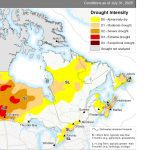SASKATOON – Benjamin Kessler has to scratch his head a minute to remember the last time he took a holiday.
It was six years ago, and he went sightseeing in Europe.
The 54-year-old Watrous veterinarian doesn’t get much time off. The life of a rural vet means long hours and hard work, Kessler said.
He likens his job working with livestock in south-central Saskatchewan to going into a wrestling ring with Hulk Hogan.
“You can’t quit until it’s all done,” he said.
Read Also

Alberta eases water access for riparian restoration
Alberta government removes requirement for temporary diversion licence to water plants up to 100 cubic metres per day for smaller riparian restoration projects
Kessler remembers staring into the nostrils of a raging bull while attending an emergency. It doesn’t happen every day, but taking that chance is just part of the job.
“It takes a lot of guts and you have to love being in the country,” said the 32-year owner and operator of the Watrous Animal Hospital. He’s become accustomed to a lifestyle of being on-call all day, every day without weekends off. He isn’t surprised to hear graduating vet students aren’t rushing out to rural areas to start up a practice.
Like people doctors, large animal vets are becoming scarce in rural and northern regions of Western Canada.
The Saskatchewan Association of Rural Municipalities passed a resolution in November urging the Western College of Veterinary Medicine in Saskatoon to strive for an enrolment that includes 50 percent rural residents. SARM also voted to set up a bursary fund for rural vet students who plan to return to a rural practice.
Redvers cattle farmer George Godenir, reeve of the rural municipality of Storthoaks, said if the vet clinic in his community closes, the nearest one will be in Carnduff, more than 65 kilometres away.
“Our vet here is 68 and it doesn’t look like anyone’s going to replace him,” said Godenir. “I’m hoping this will help the case.”
But enrolment isn’t the problem, said William Latshew, associate dean of the veterinary college at the University of Saskatchewan.
Thirty-five to 40 percent of students accepted into the program come from farms, he said. Another 40 or 45 percent are from cities and the rest are from small towns across the West.
“There’s no quick, easy solution but I’m confident admissions is not the answer,” he said, pointing instead to the lifestyle many rural vets lead. Latshew terms it “fire engine” practice where emergency calls can come at all hours, every day of the week.
Malcom Gray, registrar and executive director of the Alberta Veterinary Medical Association agreed. The shortage of rural vets has been a chronic problem in Alberta for 10 years and continues to get worse, he said.
“The lifestyle of rural veterinarians means long, hard hours of work and people end up gravitating to a place where there is less stress,” he said.
“I have no statistical data to back it up, but I feel vets in a mixed practice don’t stay as long in the practice, and in fact don’t stay as long in the field of veterinarian medicine.”
Use qualified help
Gray said the problem is magnified when farmers who are fed up waiting for emergency services, like in the case of a calving problem, end up calling in an unqualified person.
“Some farmers are calling in outside help, or the quacks of the world, who are not qualified to do the job,” he said. “Then the welfare of the animal is not protected.”
Rural communities should look at ways to make rural practices more attractive, Latshew said.
“If one person’s practice spans a 50-square-mile radius, they’re going to burn out,” he said.
Alberta’s vet association joined SARM’s fight to get Saskatchewan’s Western College of Veterinary Medicine to broaden entrance requirements to let in more students with rural backgrounds who might locate in rural areas, Gray said.
But Latshew said that wouldn’t work, and might even get the university in hot water over questionable legal and human rights issues. Besides, he said, there is no guarantee they’ll want to return to the country to practise.
“There’s absolutely no evidence that where you come from is where you’re going to end up.”
He said students seem enthusiastic about entering rural practices when they’re still in school, but that can change quickly.
“There doesn’t seem to be a lack of interest,” he said. “It is a case of burnout or the lifestyle not being the same as how they pictured it.”
Barbara Evans, a third-year vet student in Saskatoon, said she’s probably the minority in her class. Evans is from Holland, Man., and plans to return to the rural area after she graduates.
She said she knows it won’t be a nine to five job, and that’s what she finds appealing.
“There’s not the routine of knowing what’s going to happen each day,” she said, “and in a mixed practice, you get to do a bit of everything.”
Evans said many of her classmates will probably end up in larger urban centres: “They want a life.”
Kurt Hagele, registrar with the Saskatchewan veterinary medical association in charge of licensing new vets, said the fact young vets aren’t lining up to practise in rural and northern communities is simply the bleak reality.
“It is hard to get new graduates to rural Saskatchewan in mixed practices with physically demanding work in adverse conditions using 10 percent of their knowledge for blue collar work,” he said.
And Hagele isn’t optimistic rural governments can do much to change the situation.
“There are now close to 240 students graduating from four vet schools in Canada every year but you’re never going to get them to go to rural Saskatchewan and if you do, you won’t get them to stay.”
Some municipalities in Saskatchewan and Alberta have built a vet clinic to entice practitioners; others subsidize the fee vets charge to farmers. But Gray said few municipalities have the money to support these kinds of initiatives.
All parties agree there are countless questions, but few answers.
That could change with the release of a survey by the Canadian Veterinary Medical Association. Initiated by the group’s British Columbia branch, the study surveyed graduates from the country’s four vet colleges about where they practise and why.
“I guess what we want to find out is what factors cause some vets to retire prematurely or move to a non-practising job like teaching or in government,” said Diane McKelvey, a Kamloops vet who chairs the association’s national issues committee.
The association has already set up a committee with representatives from across the country to study the survey results, expected early next year, and come up with a plan of action.
Grant Spearman, head of the Manitoba vet medicine association, said a brainstorming workshop on the issue will be part of a meeting of provincial association presidents in Winnipeg in January.
“A lot of southern towns here are not particularly that exciting to live in,” Spearman said, suggesting setting up a bursary or sponsoring a student.
“Money might talk, and rural communities are going to have to take a proactive approach and go out and sell themselves.”
















